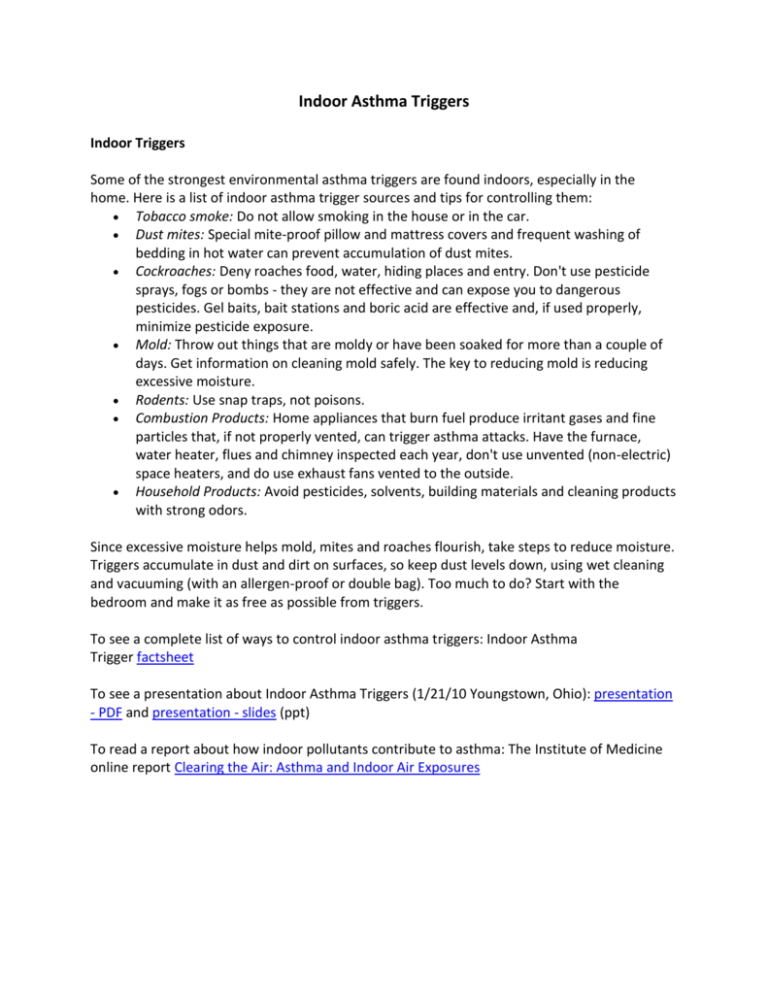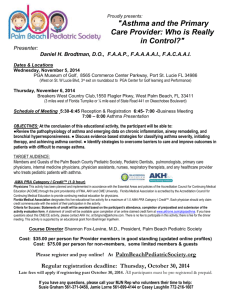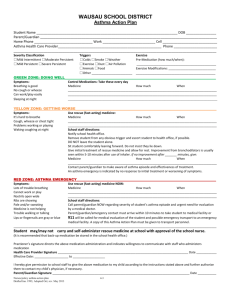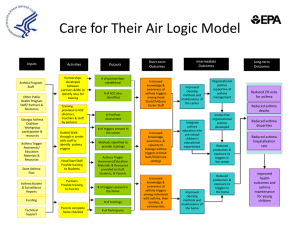Indoor Asthma Triggers - Environmental Health Watch
advertisement

Indoor Asthma Triggers Indoor Triggers Some of the strongest environmental asthma triggers are found indoors, especially in the home. Here is a list of indoor asthma trigger sources and tips for controlling them: Tobacco smoke: Do not allow smoking in the house or in the car. Dust mites: Special mite-proof pillow and mattress covers and frequent washing of bedding in hot water can prevent accumulation of dust mites. Cockroaches: Deny roaches food, water, hiding places and entry. Don't use pesticide sprays, fogs or bombs - they are not effective and can expose you to dangerous pesticides. Gel baits, bait stations and boric acid are effective and, if used properly, minimize pesticide exposure. Mold: Throw out things that are moldy or have been soaked for more than a couple of days. Get information on cleaning mold safely. The key to reducing mold is reducing excessive moisture. Rodents: Use snap traps, not poisons. Combustion Products: Home appliances that burn fuel produce irritant gases and fine particles that, if not properly vented, can trigger asthma attacks. Have the furnace, water heater, flues and chimney inspected each year, don't use unvented (non-electric) space heaters, and do use exhaust fans vented to the outside. Household Products: Avoid pesticides, solvents, building materials and cleaning products with strong odors. Since excessive moisture helps mold, mites and roaches flourish, take steps to reduce moisture. Triggers accumulate in dust and dirt on surfaces, so keep dust levels down, using wet cleaning and vacuuming (with an allergen-proof or double bag). Too much to do? Start with the bedroom and make it as free as possible from triggers. To see a complete list of ways to control indoor asthma triggers: Indoor Asthma Trigger factsheet To see a presentation about Indoor Asthma Triggers (1/21/10 Youngstown, Ohio): presentation - PDF and presentation - slides (ppt) To read a report about how indoor pollutants contribute to asthma: The Institute of Medicine online report Clearing the Air: Asthma and Indoor Air Exposures Moisture and Asthma A number of asthma triggers are associated with excess moisture, including house dust mites, mold and cockroaches. Read Jim LaRue’s Home Moisture Audit, a step-bystep guide for diagnosing moisture problems in the home. Moisture Resources Damp Indoor Spaces and Health (2004), by the Institute of Medicine, examines the relationship between damp or moldy indoor environments and adverse health outcomes, discusses how and where buildings get wet, how dampness influences microbial growth and chemical emissions, the ways to prevent and remediate dampness, and the elements of a public health response to the issues. SOEH Report: "Mold-Related Health Effects: Clinical, Remediation Worker Protection, and Biomedical Research Issue The New England Asthma Regional Council has a useful document entitled Healthy and Affordable Housing: Practical Recommendations for Building, Renovating, and Maintaining Housing to help homeowners reduce the impact of home pollutants such as moisture on persons with asthma. Pests and Asthma Roaches and Rodents - Potent Asthma Triggers Multiple factors contribute to the severity of asthma. Allergens associated with cockroaches and rodents are potent and pervasive asthma triggers. They are especially prevalent in substandard housing. For example, in the National Cooperative Inner-City Asthma Study 37% of the children were allergic to cockroach allergen. High levels of cockroach allergen was found in the dust of 50% of the children's bedrooms. Sensitivity and exposure were significantly associated with increased likelihood of asthma symptoms. IPM - Safer and More Effective Pest Control The old methods of pest control - still too commonly used - rely on monthly spraying of volatile and toxic insecticides for roaches and use of strong poisons for rodents. These methods are costly, ineffective in the long run, and potentially dangerous. Even when done properly, spraying can leave persistent pesticide residue. Irritant chemicals in some insecticide sprays can actually trigger asthma attacks (see Asthma, Children and Pesticides: What you need to know, Beyond Pesticides - National Coalition Against the Misuse of Pesticides). Poisons used for rodents are one of the most common sources of poisoning of young children. The state-of-the-art in the pest control industry is Integrated Pest Management (IPM), which is safer, more effective, and cheaper in the long run than the old methods. IPM utilizes pest monitoring, environmental controls, mechanical capture, and targeted applications of small amounts of low-volatility, least-toxic pesticides. Getting Rid of Roaches Cockroach Control Guide -web Cockroach Control Guide (PDF)- English- Black and White or Color; Spanish- Black and White orColor Get Rid of Roaches- Breather Easier (PDF)- EnglishBlack and White or Color; Spanish- Black and White or Color Roach Baits Work! - EHW's graphic guide IPM in Multi-Family Buildings EHW Model IPM Contractor Program (pdf, 6 pgs) EHW Roach Control in Public Housing (pdf, 4 pg) Integrated Pest Management in Affordable Housing, National Center for Healthy Housing A Practical Guide to Cockroach Control in Multi-family Housing Units, Purdue University Other Pest Control Links







